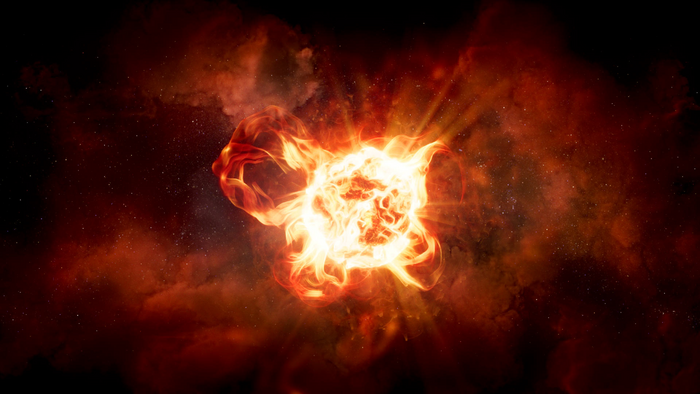Scientists watch as galaxy’s largest star dies
Scientists now have the first detailed map of the death throes of a red hypergiant star

Your support helps us to tell the story
From reproductive rights to climate change to Big Tech, The Independent is on the ground when the story is developing. Whether it's investigating the financials of Elon Musk's pro-Trump PAC or producing our latest documentary, 'The A Word', which shines a light on the American women fighting for reproductive rights, we know how important it is to parse out the facts from the messaging.
At such a critical moment in US history, we need reporters on the ground. Your donation allows us to keep sending journalists to speak to both sides of the story.
The Independent is trusted by Americans across the entire political spectrum. And unlike many other quality news outlets, we choose not to lock Americans out of our reporting and analysis with paywalls. We believe quality journalism should be available to everyone, paid for by those who can afford it.
Your support makes all the difference.Scientists now possess the most detailed image yet of a dying giant: VY Canis Majoris, quite possibly the largest star in our galaxy.
VY Canis Majoris is a red hypergiant, a class of star so massive they can stretch 10,000 times the distance between the Earth and Sun in diameter, and little is known about their final stages of life. Rather than puffing up into a big red sphere like most red giant stars, hypergiants swell into irregular tumults of arcs and protrusions, going through phases where they expel large amounts of mass.
Now an international team led by researchers from the University of Arizona traced the arcs and mass expulsions of VY Canis Majoris, providing the clearest image yet of the death throes of a hypergiant star. The team’s results were presented on 13 June at the 240th meeting of the American Astronomical Society in Pasadena, California.
"We are particularly interested in what hypergiant stars do at the end of their lives," Ambesh Singh, a University of Arizona doctoral student in chemistry said in a statement about the work. "People used to think these massive stars simply evolve into supernovae explosions, but we are no longer sure about that."
There are only a handful of hypergiants in our galaxy, and the second brightest stars in the constellation Orion, Betelgeuse, may be the best known. But VY Canis Majoris, which is located about 3,000 light years from Earth in the Southern constellation Canis Major, is the biggest of the big.
"Think of it as Betelgeuse on steroids," University of Arizona professor of chemistry Lucy Ziurys said in a statement. "It is much larger, much more massive and undergoes violent mass eruptions every 200 years or so."
To better understanding these eruptions, and the arched and knotted shape of VY Canis Majoris, Dr Ziurys and Mr Singh used the Atacama Large Millimeter Array, or ALMA, radio telescope in Chile to trace specific molecules in the matter ejected from the hypergiant star. They then mapped these traces to images of VY Canis Majoris previously taken by the Hubble Space Telescope to create maps of sulfur oxide, sulfur dioxide, silicon oxide, phosphorus oxide and sodium chloride in the material ejected from the star.
“With these observations, we can now put these on maps on the sky," Dr Ziurys said in a statement. "Until now, only small portions of this enormous structure had been studied, but you can’t understand the mass loss and how these big stars die unless you look at the entire region. That’s why we wanted to create a complete image."
The new image could help scientists better understand where there are not more supernovae explosions seen throughout the sky. Though rare in our galaxy, there are many hyper giants across the cosmos, and their fiery deaths should be visible if that’s the typical way they end their lives, Dr Ziurys said.
”We now think they might quietly collapse into black holes,” she said, “but we don’t know which ones end their lives like that, or why that happens and how."
Join our commenting forum
Join thought-provoking conversations, follow other Independent readers and see their replies
Comments